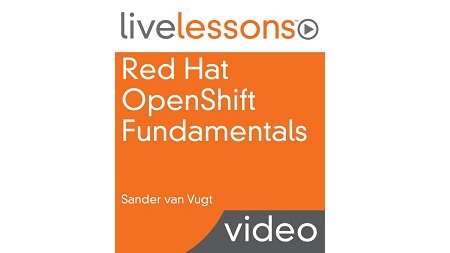
English | MP4 | AVC 1280×720 | AAC 44KHz 2ch | 3h 37m | 2.51 GB
In more than 3 hours of video instruction, Red Hat OpenShift Fundamentals LiveLessons viewers will learn how to administer Red Hat OpenShift to manage containers in an enterprise environment and to integrate them in a DevOps environment.
In more than 3 hours of video instruction, Red Hat OpenShift Fundamentals LiveLessons viewers will learn how to administer Red Hat OpenShift to manage containers in an enterprise environment and to integrate them in a DevOps environment.
Red Hat OpenShift Fundamentals LiveLessons provides an introduction to working with containers in an OpenShift environment, and covers all core aspects of working with containers in OpenShift. OpenShift is an increasingly popular platform that helps you more easily deploy applications in an enterprise environment. The platform helps developers to seamlessly roll out an application in the form of a completely operational container. At the same time, it allows administrators to manage the application life cycle in a flexible way, where applications can be monitored for availability, and easily scaled up and down if the workload requires it.
Learn how to get started with OpenShift in six lessons. In the first lesson, you’ll learn how OpenShift can help you. An explanation of what OpenShift is, and how it relates to the Kubernetes platform is provided. The second lesson discusses how to get started with OpenShift, and different installation scenarios are demonstrated. Lesson 3 shows how to deploy applications in OpenShift, and Lesson 4 will explain software-defined networking, as implemented in OpenShift. Lesson 5 discusses more advanced features, such as pod scaling and node placement; and Lesson 6 shows how to connect containers in OpenShift to storage. With a combination of white-board instruction, demonstrations, and CLI learning, Sander van Vugt demystifies OpenShift.
Learn How To
- Understand when and how to use OpenShift depending on your environment
- Install the various versions of OpenShift
- Create applications from the web console
- Creating resources using the oc command line utility
- Use source-to-image to automatically build containers from the source code
- Use software-defined networking and using SDN in OpenShift
- Work with applications, including scaling
- Handle pod scheduling
- Manage images, image streams, and OpenShift templates
- Set up OpenShift storage
Table of Contents
01 Red Hat OpenShift Fundamentals – Introduction
02 Module introduction
03 Learning objectives
04 1.1 Understanding Containers and OpenShift
05 1.2 Understanding the Red Hat Container Management Solutions
06 1.3 Understanding OpenShift in a Container Environment
07 1.4 Understanding OpenShift in a DevOps Environment
08 1.5 Understanding OpenShift Architecture
09 1.6 OpenShift versus Kubernetes
10 1.7 Understanding the Role of OpenShift in a Hybrid Cloud Environment
11 Learning objectives
12 2.1 Understanding OpenShift Versions
13 2.2 Installing Minishift
14 2.3 Using oc cluster up
15 2.4 Planning for an OpenShift Cluster
16 2.5 Installing an OpenShift Cluster – Host Prep
17 2.6 Installing an OpenShift Cluster – Installation
18 Learning objectives
19 3.1 Getting Started with the Web Console
20 3.2 Understanding Resource Types – Pods and Namespaces
21 3.3 Understanding Resource Types – Deployment Configs and Networking
22 3.4 Managing Resources from the Command Line
23 3.5 Using Source-to-Image to Create Applications
24 3.6 Basic OpenShift Troubleshooting
25 Module introduction
26 Learning objectives
27 4.1 Understanding Software Defined Networking
28 4.2 Understanding OpenShift SDN
29 4.3 Understanding Services
30 4.4 Understanding Routes
31 4.5 Creating Routes
32 Learning objectives
33 5.1 Scaling Applications
34 5.2 Scheduling Pods
35 5.3 Managing Images and Image Streams
36 5.4 Managing Templates
37 Learning objectives
38 6.1 Understanding OpenShift Storage
39 6.2 Configuring OpenShift Storage Access
40 6.3 Setting up NFS Persistent Storage Part 1
41 6.4 Setting up NFS Persistent Storage Part 2
42 6.5 Working with ConfigMaps
43 Red Hat OpenShift Fundamentals – Summary
Resolve the captcha to access the links!